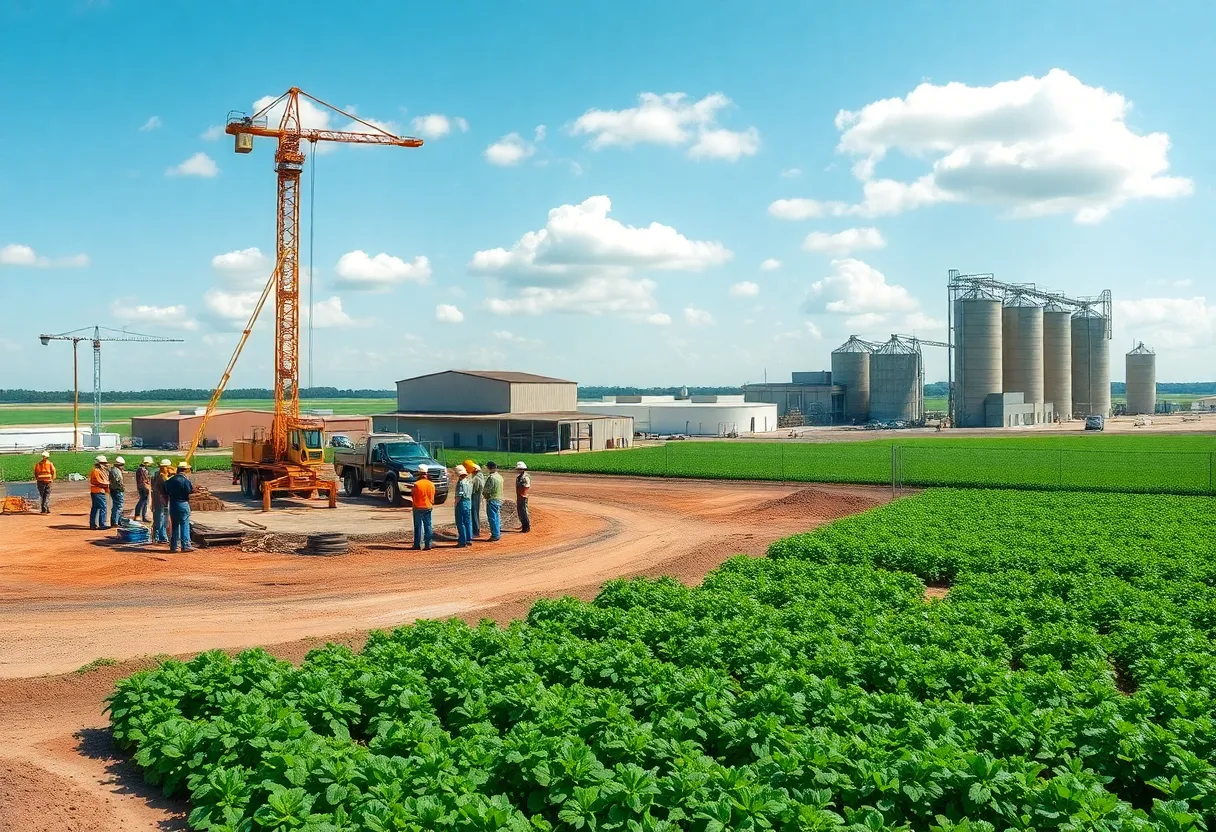Grand Forks, North Dakota, October 4, 2025
News Summary
A tightening labor market is reshaping North Dakota as nationwide construction shortages, rising wages and expanded training collide with a major industrial investment. The construction sector faces a national shortfall of about 400,000 workers while North Dakota average wages rose 4.6%. Local firms report gaps in field supervision, project management and skilled trades and are expanding apprenticeships, campus hiring and outreach. Education programs are scaling up and the planned $450 million Agristo processing facility in Grand Forks — requiring thousands of acres of potatoes and projected to create 200–300 jobs — is prompting regional workforce and agricultural planning.
Construction labor shortages, rising wages and Agristo’s $450M Grand Forks plant underscore North Dakota workforce shifts
Key point: The construction industry is facing a labor shortage of about 400,000 workers, according to the Bureau of Labor Statistics. In North Dakota, that shortage shows up alongside rising wages, new training programs and a major factory project that will create hundreds of local jobs.
What’s happening now
Supply and demand in the trades are out of balance. The construction labor gap is largely due to more people leaving the industry than entering it, and the shortage is expected to worsen in coming years. At the same time, North Dakota employers are offering higher pay: the average annual wage in North Dakota increased from $59,050 to $61,810 in the past year, a 4.6% increase.
A large new private investment is adding to local demand. Agristo’s planned U.S. facility represents a USD 450 million investment. The Grand Forks facility is projected to generate over 200 jobs upon launch and scale to more than 300 positions at full production. A ceremonial groundbreaking for Agristo in Grand Forks is scheduled for April 2026, signaling transition to full-scale construction.
Where the gaps are largest
Regionally, the hardest positions to fill in the region’s construction industry are field supervision and project management roles. Companies report continued demand for carpenters, masons and other skilled labor, and some firms say mechanical and electrical engineers are in higher demand because of mission-critical projects.
Construction employers describe the field-supervision and project-management shortage as a high-demand/low-supply market that will be aggravated as more workers reach retirement age. Early-career recruiting, internships and campus hiring are being used to build new pipelines for those leadership roles.
How companies are responding
General contractors and local firms are boosting efforts on several fronts. Several firms have expanded internship programs and early-career hiring to create pipelines into both field roles and project-management tracks. Partnerships with trade schools and registered apprenticeship programs are being emphasized to move people from entry-level work to journeyman status.
One contractor created a Registered Apprenticeship program in 2021 to build carpentry skills from little or no experience, combining classroom and on-the-job training while paying apprentices a wage. Other firms work closely with local trade schools and unions to promote pathways into the trades, and some hold regular visits to high schools to expose students to career options.
Role of unions, schools and colleges
Trade unions in North Dakota cover multiple craft disciplines and operate jointly managed classroom education with on-the-job training to build the next generation of craftspeople. Colleges and universities in the region have also expanded or updated programs. North Dakota State University offers Bachelor of Science degrees in Construction Management and Construction Engineering, a Master of Science in Construction Management, a Master of Construction Management (online) and a graduate certificate in Construction Management (online). NDSU keeps courses current with industry standards and technology and maintains third-party accreditations.
Nearby, South Dakota State University’s Concrete Industry Management program grew quickly from two students at its start to over 60 students, and the program teaches how to run ready-mix plants and manage concrete production for quality and delivery.
Wage and employment trends in North Dakota
State data show wages rising across sectors: construction and extraction occupations averaged $64,250 in 2023 and $66,150 in 2024, a 2.9% increase. Health care support and protective services occupations also saw notable year-over-year increases. North Dakota employment rose 1.7% in 2024 compared to one year prior, a gain of 7,053 jobs. Construction was among the industries with the largest employment gains, adding 1,872 jobs over the year.
Unemployment across North Dakota remains very low; about 1,300 people in the whole state are receiving unemployment benefits. Job postings show fewer than 0.5 resumes per opening in the state system, underscoring the shortage of applicants per opening.
What this means for communities and companies
Employers say retention is critical. Strategies include offering challenging work, creating clear career paths, regular check-ins on growth goals, leadership and technical training, and emphasizing company culture and long-term security. Local projects such as Agristo’s plant will increase demand for production, maintenance, logistics, quality control and management roles while also creating pull on the pool of skilled tradespeople already in short supply.
Bottom line
North Dakota’s construction sector sits at the intersection of a nationwide worker shortfall and local shifts: rising wages, new training and education investments, strong early-career recruitment, and a major industrial investment that will add hundreds of new jobs. Meeting the need will rely on expanding pipelines through high school outreach, apprenticeships, college programs and stronger retention in the years ahead.
FAQ
Q: How big is the national construction labor shortage?
A: The construction industry is facing a labor shortage of about 400,000 workers, according to the Bureau of Labor Statistics.
Q: What are the hardest positions to fill regionally?
A: The hardest positions to fill in the region’s construction industry are field supervision and project management roles.
Q: Why is there a construction labor gap?
A: The construction labor gap is largely due to more people leaving the industry than entering it, and the shortage is expected to worsen in coming years.
Q: What major investment is coming to Grand Forks?
A: Agristo’s planned U.S. facility represents a USD 450 million investment.
Q: When will Agristo break ground in Grand Forks?
A: A ceremonial groundbreaking for Agristo in Grand Forks is scheduled for April 2026, signaling transition to full-scale construction.
Q: How many jobs will Agristo create?
A: The Grand Forks facility is projected to generate over 200 jobs upon launch and scale to more than 300 positions at full production.
Q: How much did the average annual wage in North Dakota change?
A: The average annual wage in North Dakota increased from $59,050 to $61,810 in the past year, a 4.6% increase.
{
“@context”: “https://schema.org”,
“@type”: “FAQPage”,
“mainEntity”: [
{
“@type”: “Question”,
“name”: “How big is the national construction labor shortage?”,
“acceptedAnswer”: {
“@type”: “Answer”,
“text”: “The construction industry is facing a labor shortage of about 400,000 workers, according to the Bureau of Labor Statistics.”
}
},
{
“@type”: “Question”,
“name”: “What are the hardest positions to fill regionally?”,
“acceptedAnswer”: {
“@type”: “Answer”,
“text”: “The hardest positions to fill in the region’s construction industry are field supervision and project management roles.”
}
},
{
“@type”: “Question”,
“name”: “Why is there a construction labor gap?”,
“acceptedAnswer”: {
“@type”: “Answer”,
“text”: “The construction labor gap is largely due to more people leaving the industry than entering it, and the shortage is expected to worsen in coming years.”
}
},
{
“@type”: “Question”,
“name”: “What major investment is coming to Grand Forks?”,
“acceptedAnswer”: {
“@type”: “Answer”,
“text”: “Agristo’s planned U.S. facility represents a USD 450 million investment.”
}
},
{
“@type”: “Question”,
“name”: “When will Agristo break ground in Grand Forks?”,
“acceptedAnswer”: {
“@type”: “Answer”,
“text”: “A ceremonial groundbreaking for Agristo in Grand Forks is scheduled for April 2026, signaling transition to full-scale construction.”
}
},
{
“@type”: “Question”,
“name”: “How many jobs will Agristo create?”,
“acceptedAnswer”: {
“@type”: “Answer”,
“text”: “The Grand Forks facility is projected to generate over 200 jobs upon launch and scale to more than 300 positions at full production.”
}
},
{
“@type”: “Question”,
“name”: “How much did the average annual wage in North Dakota change?”,
“acceptedAnswer”: {
“@type”: “Answer”,
“text”: “The average annual wage in North Dakota increased from $59,050 to $61,810 in the past year, a 4.6% increase.”
}
}
]
}
Key features at a glance
| Feature | Detail |
|---|---|
| National construction shortage | The construction industry is facing a labor shortage of about 400,000 workers, according to the Bureau of Labor Statistics. |
| Hardest regional roles to fill | The hardest positions to fill in the region’s construction industry are field supervision and project management roles. |
| Agristo investment | Agristo’s planned U.S. facility represents a USD 450 million investment; the Grand Forks facility is projected to generate over 200 jobs upon launch and scale to more than 300 positions at full production. |
| Wage trend in North Dakota | The average annual wage in North Dakota increased from $59,050 to $61,810 in the past year, a 4.6% increase. |
| Training and hiring responses | Expanded apprenticeship programs, internships, trade-school partnerships and college updates to create pipelines into the trades and project management. |
Deeper Dive: News & Info About This Topic
Additional Resources
- PotatoPro: Agristo launches major U.S. expansion — Grand Forks potato plant
- Wikipedia: Agristo Grand Forks potato plant
- Grand Forks Herald: Statistics show North Dakota worker paychecks continue to rise on average
- Google Search: North Dakota average wage 2024
- Grand Forks Herald: RJ Zavoral & Sons built on family and driven by excellence
- Google Scholar: RJ Zavoral Sons Grand Forks construction
- City of Grand Forks: Business — Bids & RFP
- Encyclopedia Britannica: Grand Forks bids RFP
- Minot Daily News: Temporary B-1 relocation to Grand Forks approved
- Google News: Temporary B-1 relocation Grand Forks
Author: Construction CA News
The CALIFORNIA STAFF WRITER represents the experienced team at constructioncanews.com, your go-to source for actionable local news and information in California and beyond. Specializing in "news you can use," we cover essential topics like product reviews for personal and business needs, local business directories, politics, real estate trends, neighborhood insights, and state news affecting the area—with deep expertise drawn from years of dedicated reporting and strong community input, including local press releases and business updates. We deliver top reporting on high-value events such as the Rose Parade, Coachella, Comic-Con, and the California State Fair. Our coverage extends to key organizations like the California Building Industry Association and Associated General Contractors of California, plus leading businesses in technology and entertainment that power the local economy such as Apple and Alphabet. As part of the broader network, including constructionnynews.com, constructiontxnews.com, and constructionflnews.com, we provide comprehensive, credible insights into the dynamic landscape across multiple states.




